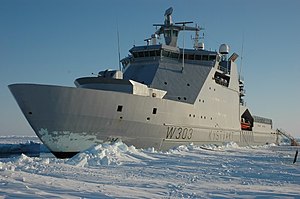Harry DeWolf-class offshore patrol vessel

Norwegian Coast Guard vessel NoCGV Svalbard, on which the class is modelled
|
|
| Class overview | |
|---|---|
| Name: | Harry DeWolf class |
| Builders: | Halifax Shipyards |
| Operators: |
|
| Cost: | |
| Building: | 2 |
| Planned: | 6 |
| General characteristics | |
| Type: | Patrol vessel |
| Displacement: | 6,440 metric tonnes |
| Length: | 103.6 m (340 ft) |
| Beam: | 19 m (62 ft) |
| Installed power: | Four 3.6 MW (4,800 hp) generators |
| Propulsion: | Diesel-electric; two shafts (2 × 4.5 MW (6,000 hp)) |
| Speed: |
|
| Range: | 6,800 nautical miles (12,600 km) |
| Boats & landing craft carried: |
Two multi-role rescue boats |
| Complement: | 65 |
| Sensors and processing systems: |
AESA Radar, MESA 4D Radar, SATCOM (Link 16), Multichannel VHF/HF Radio, Anti-missile detect systems, Sonar, SAGEM Integrated Bridge Navigational System, and Damage/Machinery Control Systems |
| Armament: |
|
| Aircraft carried: | |
| Aviation facilities: |
|
The Harry DeWolf-class offshore patrol vessel is a Government of Canada procurement project for the Royal Canadian Navy (RCN) that is part of the National Shipbuilding Procurement Strategy. The class was previously referred to as Arctic Offshore Patrol Ship (AOPS). In July 2007 the federal government announced plans for acquiring six to eight icebreaking warships for the RCN.
The vessels had been speculated to be modelled on the Norwegian Svalbard class and as of 2007 were projected to cost $3.5 billion (CAD) to construct with a total project procurement budgeted to cost $4.3 billion in order to cover maintenance over the 25-year lifespan of the vessels.
The lead ship of the class was announced as Harry DeWolf in September 2014, and four additional ships were named in January 2015. Construction of the ships Harry DeWolf and Margaret Brooke started in September 2015 and September 2016 at Halifax Shipyards, respectively. Both ships are expected to be delivered and in-service by 2018. Max Bernays and William Hall will begin construction in 2017, with Max Bernays to be delivered by late 2019, and William Hall by early 2020. Frédérick Rolette and the Robert Hampton Gray, are planned to be in service by 2021 and 2022, respectively. Both Harry DeWolf and Margaret Brooke are planned to be retired from service and decommissioned by 2043.
In 2006 Prime Minister Stephen Harper had spoken about building three to four icebreakers capable of travelling through thick ice in the Arctic Ocean. In 2007 it was announced that the Canadian Forces would purchase six to eight patrol ships having an ice class of Polar Class 5, meaning that they were capable of limited ice breaking, based on the Svalbard class. This announcement was met with some controversy, and the proposed ships have been called "slush-breakers", by Dr. Gary Stern, a scientist aboard CCGS Amundsen, and Jack Layton of the NDP. However, it is notable that of the nineteen Canadian Coast Guard icebreakers currently in service, only six have a polar class higher than PC 5.
...
Wikipedia
